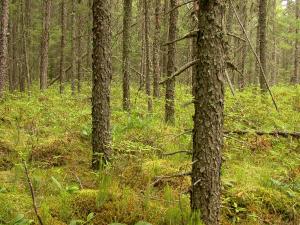Minnesota’s 17.4 million acres of forest land comprise 22 percent of Minnesota's land area. Minnesota’s forests are used for timber production, recreation, wildlife habitat, and increasingly, for home sites. The forest products industry is Minnesota's fifth largest manufacturing sector by employment. It provides over $17 billion in economic impact and creates 64,500 jobs.
Forested landscapes are a mix of private, tribal and public land. Of the 15 million acres of commercially productive timberland in Minnesota, county/municipal, state, and federal levels each own between 13 and 18 percent. Private, tribal and industry-owned lands constitute the largest block of landholdings, at 53 percent or approximately 8 million acres (see DNR, Minnesota Facts & Figures: Forests).
Private landowners manage approximately 6.8 million acres, or 40 percent of forest lands. Managing these private forest lands is complicated by the large number of owners and the multiple entities that provide services to these owners. A recent USDA survey shows considerable fragmentation into small holdings. Ownership of less than 20 acres is the fastest growing category. According to a recent USDA Forest Service forest inventory analysis, there are more than 125,000 landowners in the 0-20 acre category. Many of these smaller parcels are in sensitive areas adjacent to lakes, streams, and rivers.
Many of these small tract owners are not interested or able to manage their property for timber/fiber production. They are far more interested in other recreational uses of their property, as indicated by survey research.
It is expected that the cost and value of wood products will continue to increase, along with the increasing fragmentation of smaller holdings of timberland. This makes management of these lands even more critical.
Landscape Stewardship Plans
Landscape stewardship is an “all lands” approach to forest management. Created by the US Forest Service, it addresses multiple conservation challenges through the practical application of science and collaboration. It is based on five working principles: 1) Invest in priority areas, 2) Build a collaborative network of service providers that effectively work together to serve more landowners, 3) Appeal to interests of both landowner and service providers, 4) Manage for results, and 5) Encourage flexibility at all levels to be more adaptive and cooperative in serving customers.
Watershed-based landscape stewardship plans (LSPs) analyze the critical contexts between land cover and water quality in ways useful to local water planning. They are specifically designed to bring the broad range of service providers (federal, state, local, private and non-governmental) together to service the 190,000 family forest landowners across the state. LSPs have 2 primary goals: 1) increase working forestland protection to practical levels to protect water resources as well as provide other public benefits; and 2) promote forest stewardship. LSPs are also designed to integrate forest management recommendations into comprehensive watershed management plans (under One Watershed One Plan).
Managing Private Forests on a Landscape Level (pdf) summarizes the process of developing landscape stewardship plans, their relationship to comprehensive watershed management plans, and the prioritize-target-measure approach to watershed management.
Site Level Forest Management Planning
The Minnesota Forest Resources Council has developed two landscape-scale plans to guide local planning efforts:
Below is the general sequence of concepts and products that were integrated into and/or developed for the North Central and East Central landscape plans. This outline provides a suggested ecological pathway to help land managers and owners work from the landscape scale down to the site level when planning specific forest management activities.
Ecological Classification System: Field guides have been developed by the Minnesota Department of Natural Resource to the Native Plant Communities of Minnesota. These guides provide a wealth of information about the different types of plant communities in Minnesota, their environmental conditions and species composition.
Potential Native Plant Communities: Geospatial modeling of native plant communities of Minnesota’s Laurentian Mixed Forest shows areas of potential native plant communities to guide reforestation efforts.
Spatial planning category inventory and native plant community crosswalks
Vegetation Management Framework goals and strategies
Climate change considerations and strategies
- Climate Change Field Guide for Northern Minnesota Forests: Site-level consideration and adaption
- Minnesota Private Landowner Climate Scorecard
Silvicultural considerations
- MN DNR tree suitability table
- MN DNR: NPC silviculture strategies for forest stand prescriptions
- Great Lakes Silvicultural Library
Related Planning/Conservation Programs
- One Watershed, One Plan (1W1P). Plans created under the 1W1P program address many issues relevant to the management of forest land, including water quality protection and restoration, flood mitigation, and habitat enhancement for fish and wildlife.

